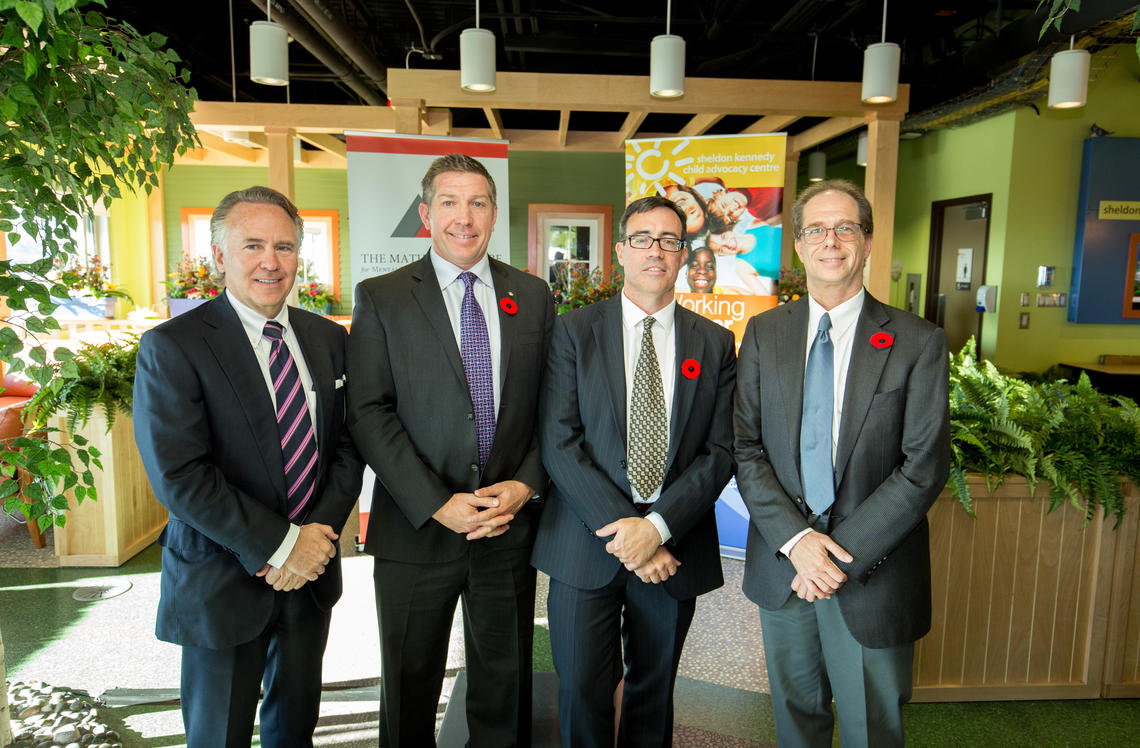
From left: Ronald Mathison, Sheldon Kennedy, Dr. Paul Arnold, and Sam Weiss.
Adrian Shellard
Nov. 10, 2016

From left: Ronald Mathison, Sheldon Kennedy, Dr. Paul Arnold, and Sam Weiss.
Adrian Shellard
A new partnership between the Sheldon Kennedy Child Advocacy Centre (SKCAC) and the University of Calgary’s Mathison Centre for Mental Health Research and Education will study the impact of child abuse on the developing brain. The goal is to use a scientific approach to understand which interventions work best to mitigate the impact of child abuse, to compare the impact of childhood sexual abuse to that of other forms of childhood trauma, and to understand why some children are more resilient than others.
“I am so excited to see this collaboration between the SKCAC and the Mathison Centre to examine the impact of childhood abuse on the neurobiological and psychosocial development of young victims,” says Sheldon Kennedy, lead director at the SKCAC. “For 20 years I’ve been working to help people really understand the impacts of child abuse; make the invisible visible. This research will help us do exactly that.”
MRI scans will examine differences in brain structure and chemistry
As part of this study, children will receive an MRI scan of their brain to determine differences in structure and chemistry between participants who have experienced child abuse and those who have not. Researchers will also take saliva samples to analyze DNA, which could indicate epigenetic changes (changes in the genome caused by external factors) caused by environmental influences such as stress. Such epigenetic modifications of DNA structure caused by toxic stress could in turn lead to changes in brain structure, function and chemistry.
“Despite emerging evidence that child abuse impacts the developing brain, the nature and extent of the effects are not well understood,” says Dr. Paul Arnold, child psychiatrist and director of the Mathison Centre at UCalgary’s Cumming School of Medicine. “This study will impact care and provide a framework for personalized care informed by science.”
First phase of study involves 240 children
This first phase of the study is a two-year pilot study enrolling 240 children ages six to 17. Half of the study participants will be controls, and half will have experienced childhood abuse. The study will look at clinical and biological factors and how they relate to outcomes.
After the initial pilot study, researchers hope to expand the study and enrol up to 1,000 children and follow them over a 10- to 15-year time period. The planned longitudinal study will be one of the most comprehensive studies of child abuse victims ever conducted.
The SKCAC screens about 125 children for child abuse each month, with two-thirds of those cases related to sexual abuse. Childhood abuse increases the risk for mental health problems, including anxiety, depression, substance abuse and suicide.
Community partnerships put knowledge into action
“Brain and mental health research partnerships with our community enable University of Calgary scientists to put knowledge into action and ultimately improve the lives of the children, youth and families we serve. We look forward to working closely with Sheldon and the Child Advocacy Centre on this vital new project,” says Samuel Weiss, PhD, director of the Hotchkiss Brain Institute and leader of the University of Calgary’s Brain and Mental Health strategy.
Led by the Hotchkiss Brain Institute (HBI), Brain and Mental Health is one of six strategic research themes guiding the University of Calgary towards its Eyes High goals.
Dr. Paul Arnold is the Director of the Mathison Centre for Mental Health Research & Education at the University of Calgary, Cumming School of Medicine. He is a member of the university’s Hotchkiss Brain Institute (HBI)). He is an Associate Professor in the Department of Medical Genetics and Psychiatry.